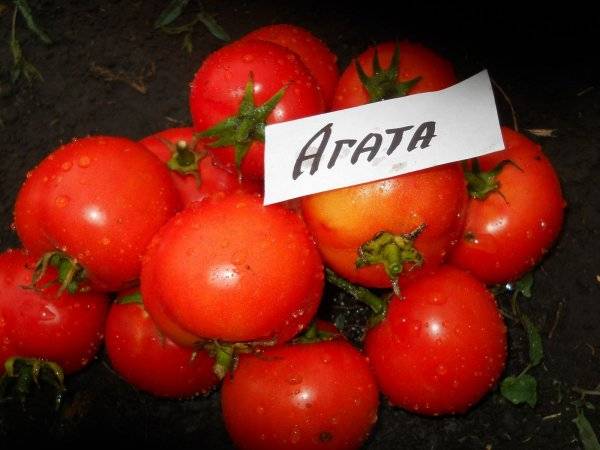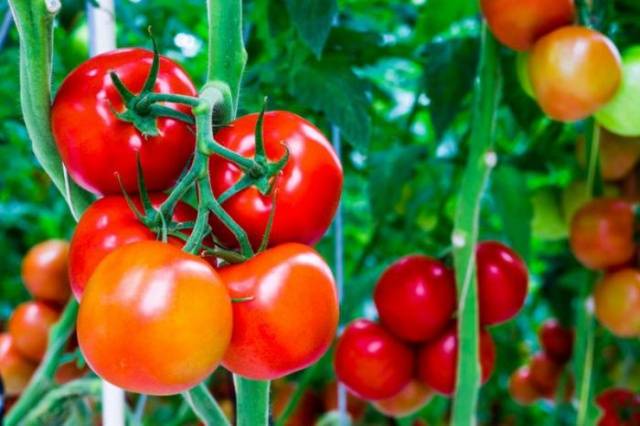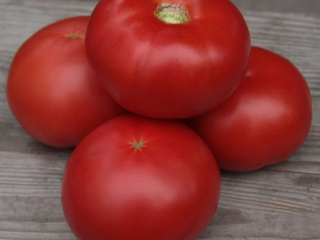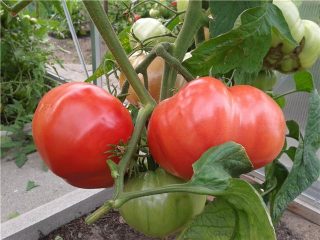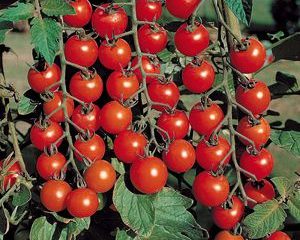Content
Every gardener, wanting to get an early harvest of vegetables from his plot, tries to devote part of the garden bed to the appropriate varieties. Early ripening tomatoes are always a priority, especially for cold regions. The fruits may not be large in size, but they are distinguished by excellent taste and aroma. A lot of early tomatoes have been bred. One of the varieties tested by vegetable growers is the Agata tomato, characterized by a compact bush and high yield.
Description of the variety
Almost all early tomatoes are low-growing. This is the main distinguishing feature of culture. Considering the characteristics and description of the Agata tomato variety, it is worth noting that the plant belongs to the determinant group, but the bush is not standard. The stem grows only 33 cm in height. Sometimes it can stretch up to 45 cm. The fruits are tied in clusters. There are a maximum of five of them on a plant. The first brush is formed above the fifth leaf, and all subsequent ones appear after two leaves. After the formation of the last fifth cluster, the tomato stem stops growing, and all the energy is directed to ripening the fruit.
A low-growing tomato can do without a garter to a trellis, but the bush is not standard.The stem is not able to independently hold five clusters, each of which contains from 3 to 6 tomatoes. Under the weight of the fruit, the bush bends to the ground. Tomatoes may rot if they come into contact with the soil. The solution to the problem will be supports. It is enough to drive a peg into the ground near each bush and tie a tomato stem to it. A plant fixed to a support is better illuminated by sunlight, plus it is blown by fresh wind. This reduces the risk of late blight.
The Agata tomato ripens in 95–100 days from the moment the seeds germinate. The yield for such a small bush is high - up to 4 kg of fruit. According to reviews, the Agata tomato variety shows excellent results with open and closed growing methods. The agricultural technology of the crop is simple. Tomato can be grown by seeds and seedlings. The second method is considered preferable.
Looking at a photo of an Agata tomato variety, you can verify the beauty of the fruit. Tomatoes grow almost the same size. The shape of the fruit is round, slightly flattened. The walls are smooth, only in the area where the stalk is attached there is slight ribbing. The unripe fruit has a dark pink top and orange back and sides. A ripe tomato turns completely bright red. The fruits weigh a maximum of 100 g.
Despite the early ripeness of the variety, the tomato pulp is dense and covered with a durable skin. This is another distinctive feature of the Agata tomato, due to which the fruits are resistant to cracking. Ripe tomatoes tolerate transportation well and are canned. The skin of the fruit does not wrinkle during heat treatment. The tomato remains beautiful in the jar and on the table. In addition to canning, the Agata tomato is suitable for fresh consumption, preparation of various dishes, and juice.
The Agata tomato variety is weakly resistant to diseases. However, early ripening times help out the tomato. The plant manages to yield almost the entire harvest before the outbreak of late blight and other nightshade diseases. Tomato Agata grows best in a bed where cucumbers, carrots, salad greens or legumes grew last summer. Tomato loves fertile soil. It is advisable to choose an area with light soil. If this is not the case, then loosen the soil by adding sand.
Advantages and disadvantages of the variety
Probably, the characteristics of the Agata tomato will be incomplete if we miss an overview of the advantages and disadvantages of the variety. Let's start with the good qualities:
- early ripening of fruits allows you to quickly obtain a harvest;
- the fruits are universal, do not crack and have an excellent presentation;
- the Agata variety allows you to get a harvest, even if the vegetable grower has made a minimum of effort to care for the crop;
- in warm regions, you can abandon the seedling method of growing and sow tomato seeds directly into the garden bed;
- the tomato variety is suitable for greenhouse cultivation, which is important for cold regions;
- uniform ripening of fruits, with all tomatoes growing the same size.
Despite the large number of positive qualities, the Agata tomato has a couple of disadvantages:
- in the event of an early outbreak of an epidemic, tomato plantings are affected by late blight;
- the rather weak stem has to be tied to a support so that the lower tier of fruit does not touch the ground.
In principle, the listed disadvantages are typical for most varieties of tomatoes. The problem can be dire if appropriate measures are not taken in time.
Features of using the crop
We have already talked about the versatility of the Agata tomato fruit. Early ripening fruits are most often consumed fresh. Tomatoes are also great for processing, but the vitamins in the overcooked pasta or fruit drink are not preserved. Experienced housewives have found a solution to this problem. In order to preserve all the beneficial substances to the maximum, the juice from the ground fruits is not boiled. It is heated to a temperature of 70OC, after which they are rolled up with metal lids in jars. This recipe allows you to taste the taste of a tomato freshly picked from the garden in winter.
In the video you will find information about the Agata tomato:
Agricultural technology of culture
The technology for growing the Agata variety does not differ much. Let's look at what actions a vegetable grower needs to perform in order to ultimately get a generous tomato harvest.
Sowing seeds
Strong seedlings are the key to a good tomato harvest. You can get it from high-quality seeds, but they need to be sown in fertile soil. It is better to buy soil for tomato seedlings in the store. It is completely disinfected and has all the necessary beneficial additives. If the soil is collected from the garden bed, it is calcined in the oven and watered with a manganese solution. Organic matter and complex fertilizers are used as nutritional supplements.
Tomato seeds are sown for seedlings in March. Here it is better for the vegetable grower to navigate himself, taking into account the weather conditions of the region. If the seeds are collected yourself, then it is advisable to subject them to preparatory procedures. First, the tomato grains are immersed in a jar of saline solution for about 15 minutes. The pacifiers will definitely all float to the surface. These seeds will not sprout and must be disposed of. The remaining grains are washed with clean water, pickled with manganese, and then laid out on a wet napkin for germination.
Sowing of the hatched seeds of Agata tomatoes is carried out in grooves 1.5–2 cm deep. Until the shoots emerge, the containers with the crops are kept warm, covered with a transparent film. Sprouts usually appear no later than seven days. Now the film will need to be removed and the boxes with tomato seedlings placed on the windowsill.
After two adult leaves appear, I pick out the tomato seedlings into cups. On the third day, fertilizing is applied. Before planting in open ground, young tomatoes are hardened off. You can take the seedlings outside for a week or open the window in the room where the tomatoes are growing.
Planting tomatoes in the garden
Agata tomato seedlings are planted in the garden in mid-May. Usually this is the 15th–20th. In most regions the weather is already warm, but night frosts are possible. Protect tomato plantings with film cover. It’s enough just to place arcs over the bed and lay the canvas on top.
For colder regions, the time of planting in open ground is shifted to mid-June. At this time, you can already do without installing a film cover.However, late planting does not guarantee that the tomatoes will have time to ripen before the dangerous period associated with the occurrence of late blight.
The Agata variety is characterized by the small size of the bush. Tomatoes can be planted according to the 50x50 cm pattern. At 1 m2 four plants will feel free.
Features of tomato care
The Agata variety is easy to care for. Tomatoes will not cause much trouble for a vegetable grower. Regular watering is a mandatory procedure. It is not advisable to use cold water from a well. The tomato's growth will be stunted. It is better to water with warm water, but for this you will need to place a storage tank on the site.
Tomatoes are fertilized three times throughout the entire season. You can use factory-made complex fertilizers. However, the Agata variety is well susceptible to organic matter. Tomatoes respond well to humus from leaves and mullein, wood ash, and egg shells. You can add a weak solution of chicken manure to the bushes.
Tomato bushes do without the obligatory stepson. The foliage of the lower tier is removed to free up sun access to the fruits. If the vegetable grower believes that too many shoots have grown, then some of them can be removed. The soil under the tomatoes is kept slightly moist. It is optimal to cover the ground with mulch. Overmoistening is unacceptable for the Agata tomato. There is a threat of fungus. Plants love periodic loosening of the soil. Weeds can clog low-growing bushes, so they need to be removed promptly.
Late blight poses a great danger to the Agata tomato. It is better not to wait for an outbreak of an epidemic, but to carry out preventive spraying of plantings with a solution of Bordeaux mixture in advance.
Reviews
There are different reviews about the Agata tomato.Some vegetable growers like the variety, others don’t. Let's look at a couple of striking examples.
